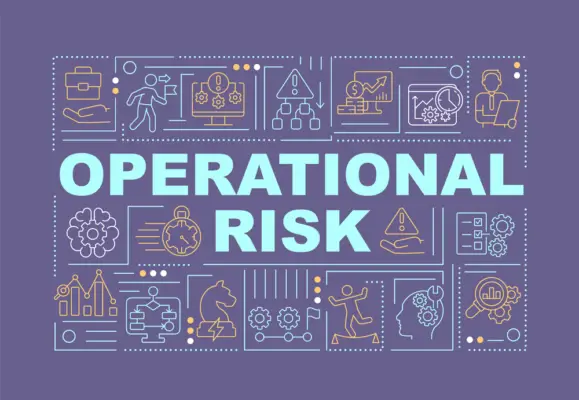Risk and Control Self-Assessment (RCSA) is vital for financial institutions’ compliance because it helps to identify and mitigate risks, which is a critical component of regulatory compliance.
By using RCSA techniques as part of an integrated risk management strategy, banks and other financial institutions can analyze, evaluate, and manage risks more effectively, resulting in a safer and more stable financial system (source: The Global Treasurer).
Additionally, RCSA can be used by senior management for the purpose of top-down risk assessment, or it can be carried out on a bottom-up basis, which makes it a versatile tool for ensuring that risks are identified and addressed throughout the organization (source: FinLync).
Risk Control Self-Assessment (RCSA) is a beacon of compliance and risk management for financial institutions. With the regulatory landscape becoming increasingly complex and demanding, establishing a comprehensive understanding and effective implementation of RCSA becomes crucially paramount.
This article delves into the essence of RCSA, its potent role in risk management, its significance in ensuring regulatory compliance, the challenges impeding its implementation, and the pioneering strategies reshaping its future.
Navigating through these layers of understanding equips professionals with a holistic perspective on the vital indispensability of RCSA in the financial compliance arena.
Understanding RCSA
The dynamics of the business world are continually evolving, and staying ahead of the curve is a mandate rather than an option. A quintessential element in this context is Risk Control Self-Assessment (RCSA), a strategic business tool that operations managers, risk professionals, and executives simply cannot ignore.
Understanding RCSA and valuing its importance can aid a company in navigating the ever-challenging business landscape. So let’s delve in, shall we?
In a nutshell, RCSA is a process through which businesses or other organizations can methodically evaluate and manage their operational risks. Using a strategic toolkit, potential risks are identified, their impacts assessed, and appropriate actions taken to mitigate those risks.
Driving deeper into the concept; RCSA is a comprehensive, top-down, and bottom-up practice involving management, personnel, and often the board.
It creates a platform for open discussions, dynamic evaluations, and consistent reporting patterns – a self-regulating mechanism perfect for our current fast-paced, high-uncertainty business environment.
But why should businesses pay close attention to RCSA?
Firstly, the methodical approach of RCSA can help build an organization’s risk awareness, making internal processes more transparent and efficient. Remember, risk knowledge is power, and power can maneuver a business out of potential pitfalls.
Secondly, it equips executives to anticipate risks before they happen. Anyone can see the importance of having an early heads-up about possible threats, saving time, resources, and potential reputational loss by mitigating them before they escalate.
Lastly, adhering to RCSA helps firms achieve regulatory compliance. Essentially, having a formalized RCSA process demonstrates to regulators that an organization is proactive about risk management.
A proactive stance is always favorable in the eyes of scrutinizing regulatory bodies, helping to foster trust and facilitate smoother business operations.
RCSA is an indispensable tool in creating a resilient and robust business model, fostering a culture that embraces resilience. By ensuring transparency, predictability, and compliance, RCSA facilitates sustainable growth and longevity in the challenging, exhilarating world of business.

RCSA and its Role in Risk Management
Harnessing the Power of RCSA for Superior Risk Management in Financial Institutions
In the rapidly transforming financial landscape, the Risk Control Self-Assessment (RCSA) has righteously emerged as a critical tool.
Its compelling, meticulously curated methodology is an imperative part of effective risk management systems in financial institutions and beyond. So, how exactly does the RCSA contribute to fortifying risk management in these institutions?
To bring the impact of RCSA into sharper focus, let’s first consider its role in fostering a dynamic risk culture. Financial institutions experiencing a high rate of change due to factors such as mergers, acquisitions, digitization, and fluctuating markets benefit greatly from RCSA.
The process encourages a participatory approach where each department, in assessing and analyzing its risks, further ingrains risk-consciousness within the organization. Undoubtedly, this culture plays a monumental role in shaping a sustainable, resilient institution.
Moreover, RCSA proves to be invaluable in enhancing the risk oversight capability of the board. Risk evaluation conducted at the grassroots level gives the management an all-encompassing view of the institution’s risk landscape.
They can streamline their decision-making process based on this accurate and current risk information, acting proactively rather than reactively.
RCSA also excels in shaping and improving the institution’s risk appetite and tolerance. By determining potential risks and measuring them against prevailing controls, financial institutions can accurately gauge what risk measures they can absorb, balancing risk and reward more competently.
It helps align the institution’s strategic goals with its risk capacity, elevating the effectiveness of its overall risk management paradigm.
Moreover, RCSA acts as a conduit for continuous improvement, an aspect of paramount importance to modern financiers.
In an ever-evolving financial environment, RCSA aids in the identification of areas that need improvement or those that pose new, unmeasured risks. The process initiates a constructive dialogue on possible control enhancements and risk mitigation tactics, helping institutions stay ahead of the curve.
In the area of regulatory compliance, the RCSA process provides a roadmap for institutions. Regulatory authorities worldwide endorse comprehensive risk self-assessments as they attest to an institution’s commitment to maintaining a robust internal control system.
In this manner, RCSA not only aids in fulfilling compliance requirements but also in promoting trust and credibility among customers, stakeholders, and regulators.
The process is a potent instrument for enhancing the strength and resilience of financial institutions. It influences and shapes the risk culture, improves risk oversight, defines risk appetite, drives continuous improvements, and aids in regulatory compliance.
As the world of finance continues to evolve at a dizzying pace, embracing the process is no longer an optional good practice – it’s a strategic necessity.

RCSA for Regulatory Requirements
Navigating the ever-shifting landscape of financial regulations can prove quite challenging for financial institutions, where regulatory and compliance risks are abundant.
To navigate these unchartered territories successfully, emerges as a beacon, providing a thorough and systematic approach that enables these entities to adhere to stringent regulatory requirements.
RCSA offers a fundamental shift in the path to financial institutions’ success, aligning them to the dynamic and demanding regulatory landscape.
Chief among its offerings is the institution of a robust risk culture. By facilitating candid discussions and promoting transparency in risk assessments, permeates the organization’s depth and breadth, weaving a tapestry of competent risk intelligence.
This proactive risk culture empowers financial institutions to anticipate and mitigate not only the evident risks but also the less apparent ones.
Risk oversight, a critical component of every resilient business model, is greatly beneficial. It enhances the board’s capacity to monitor, manage, and mitigate risks effectively.
RCSA ensures a thorough flow of risk-related information to the leaders while ensuring that key personnel at all levels acknowledge and manage their risks efficiently.
In doing so, the risks residing within the varied layers of the organization come to the forefront, allowing for well-informed decisions centered around risk mitigation strategies.
Setting risk appetite and tolerance levels might seem like a daunting task, but RCSA’s role here is transformative. It provides a unique perspective to risk management, wherein the risks associated with various activities and decisions are weighed against the strategic business objectives.
In this delicate balancing act, RCSA provides competence and precision, aiding financial institutions in determining their risk-foodprint and aligning it with their strategic goals in compliance with regulations.
RCSA’s value is truly evident in its capacity to catalyze continuous improvement in risk management processes. By offering a framework for risk control, it identifies potential pitfalls in current strategies and assists institutions in rectifying them.
The result is a proactive rather than reactive approach to risk management, an approach that seamlessly aligns with the conscientious culture of consistent improvement.
Lastly, perhaps the most gratifying contribution is in the realm of regulatory compliance. The structured and systematic process of RCSA provides assurance to external regulators and stakeholders of a well-managed risk environment.
It enhances trust and confidence among stakeholders while assuring them of the institution’s adept management of risk and regulatory requirements.
Moving in stride with the rapidly transforming financial landscape demands resilience, a resilience spawned from a dynamic risk culture, efficient risk oversight, sound risk appetite and tolerance, continuous improvement, trust, and, most importantly, compliance.
To this end, it serves not merely as a tool but as a strategically designed scaffold to maintain and enhance financial institutions’ standing in these challenging times. In this critical juncture, the question is not ‘Why RCSA?’ but rather ‘How not RCSA?’.
The answer is clear: financial institutions must incorporate into their operational framework to navigate the demanding, complex, and, indeed, thrilling world of modern finance.

RCSA Implementation Challenges
Risk Control Self-Assessment for Effective Operational Risk Management
RCSA, without a doubt, is indispensable in managing operational risks, fostering a dynamic risk culture, and ensuring overall compliance. However, implementing a risk control self-assessment is no walk in the park.
Companies often encounter several pitfalls and challenges while executing their RCSA. By understanding and addressing these challenges head-on, companies can reap the full benefits of it.
Firstly, a common issue is that of scale and complexity. A comprehensive RCSA process necessitates evaluating a myriad of operationally distinct processes, including IT infrastructure, human resources, financial controls, etc.
Maintaining objectivity while ensuring a thorough risk-based approach in evaluating these areas can be a daunting task. However, the integration of technology solutions can streamline this process, affording companies the ability to gather data more effectively and use analytics to gain better insights.
Another challenge many companies face is a misalignment of perceived risks across different levels of hierarchy. From front-line employees to higher management levels, the perception of risk might vary.
A breakdown in risk communication can lead to a disconnect between strategic risk direction and operational realities. To mitigate this, it is critical to ensure clear communication and foster an inclusive risk culture where all employees understand their role in risk management.
Thirdly, companies often struggle with standardizing risk definitions and categorizations due to the unique nature of their operations.
This inconsistency hampers the ability of businesses to have a shared understanding of risk profiles and control mechanisms. An enterprise-wide risk taxonomy can help to bring consistency in risk reporting and control self-assessment.
Lastly, a significant pitfall that companies often experience is underestimating the importance of monitoring and review in the process. Effective performance measurement is a critical aspect of the process.
By leveraging key risk indicators (KRIs) and utilizing automated systems for real-time tracking, organizations can achieve high-level oversight and enable continuous improvement.
While the road to implementing a successful model has its hitches, understanding and proactively addressing common pitfalls can set businesses on the path toward improved risk awareness, efficient operation, and far-reaching business resilience.
Through judicious understanding and strategic planning, organizations can harness the full potential of risk control self-assessment.

Pioneering RCSA Strategies
Pioneering the Application of RCSA in Financial Institutions: Exploring Cutting-edge Approaches
Despite the widespread acknowledgment of this risk management tool, RCSA’s application still presents certain challenges that innovative approaches aim to address. This section will explore these distinctive and cutting-edge strategies that have helped turn RCSA into a dynamic strategic lever for financial institutions.
First, tackling the scale deceptively inherent in conducting RCSAs is crucial. Given the breadth and depth of risk exposure in financial institutions, even the process of identifying potential risks can be gargantuan.
In response to this, forward-thinking institutions have adopted a tiered approach to RCSA that facilitates risk prioritization. By creating a hierarchy of risks based on potential impact or likelihood of occurrence, institutions can focus on higher-level risks, thus optimizing their use of resources.
The next pioneering approach addresses the evident issue of hierarchy and perceived risks. In many financial institutions, understanding and perception of various business risks vary across different hierarchical levels. This can lead to inconsistent risk ratings and misaligned actions.
However, by including all levels of personnel in the RCSA process and promoting open communication, a more realistic and comprehensive picture of the organization’s risk profile can be developed.
Recognizing the crucial role of standardized definitions also marks a shift from traditional thinking. By providing clear, concise, and universally accepted risk definitions and categorizations, organizations create a common language of risk that enhances communication, limits ambiguity, and promotes a more coherent risk culture across all levels.
This standardization not only streamlines the review process but also ensures the comparability of risk assessments over time.
Last, innovative firms champion the idea of transforming RCSA from a static, one-time activity into a continuous process. Where many underestimate the importance of monitoring and review, these firms appreciate that changes in the business environment or internal processes can alter risk profiles at any given moment.
As such, they have adopted the practice of continually monitoring and reviewing their risk assessments, modifying them as necessary, and documenting changes and reasons behind such alterations.
Each of these pioneering approaches enriches the RCSA process, creating robust risk management frameworks that are adaptable, inclusive, and effective.
As financial institutions continue to confront a rapidly changing environment filled with both challenges and opportunities, the innovative application of tools like RCSA remains a powerful strategy to navigate successfully.
Pioneering tactics and continuous evolution should, therefore, be a central theme for all financial institutions striving for resilience and growth in an era of transformative change.
RCSA is undoubtedly a pivotal instrument that aids institutions in painting a comprehensive picture of their risk landscape. With the continuous development and adoption of new, pioneering approaches, it becomes an ever more effective tool equipping financial institutions with a solid foundation to grow, innovate, and excel in today’s complex and competitive market.

Conclusion
Primarily, the comprehensive understanding, implementation, and advancement of RCSA strategy is a tool of immense value to any financial institute aiming for regulatory compliance and robust risk management.
By combating the hurdles of implementation, embracing the latest strategies, and staying abreast of the dynamic regulatory environment, financial institutions can capitalize on the power of RCSA to validate compliance and safeguard their operations.
Ultimately, proficiency in RCSA not only enhances risk detection and control efficiency but also fortifies institutional resilience in the face of potential threats, thereby cementing its indispensability in the financial compliance landscape.

Chris Ekai is a Risk Management expert with over 10 years of experience in the field. He has a Master’s(MSc) degree in Risk Management from University of Portsmouth and is a CPA and Finance professional. He currently works as a Content Manager at Risk Publishing, writing about Enterprise Risk Management, Business Continuity Management and Project Management.

